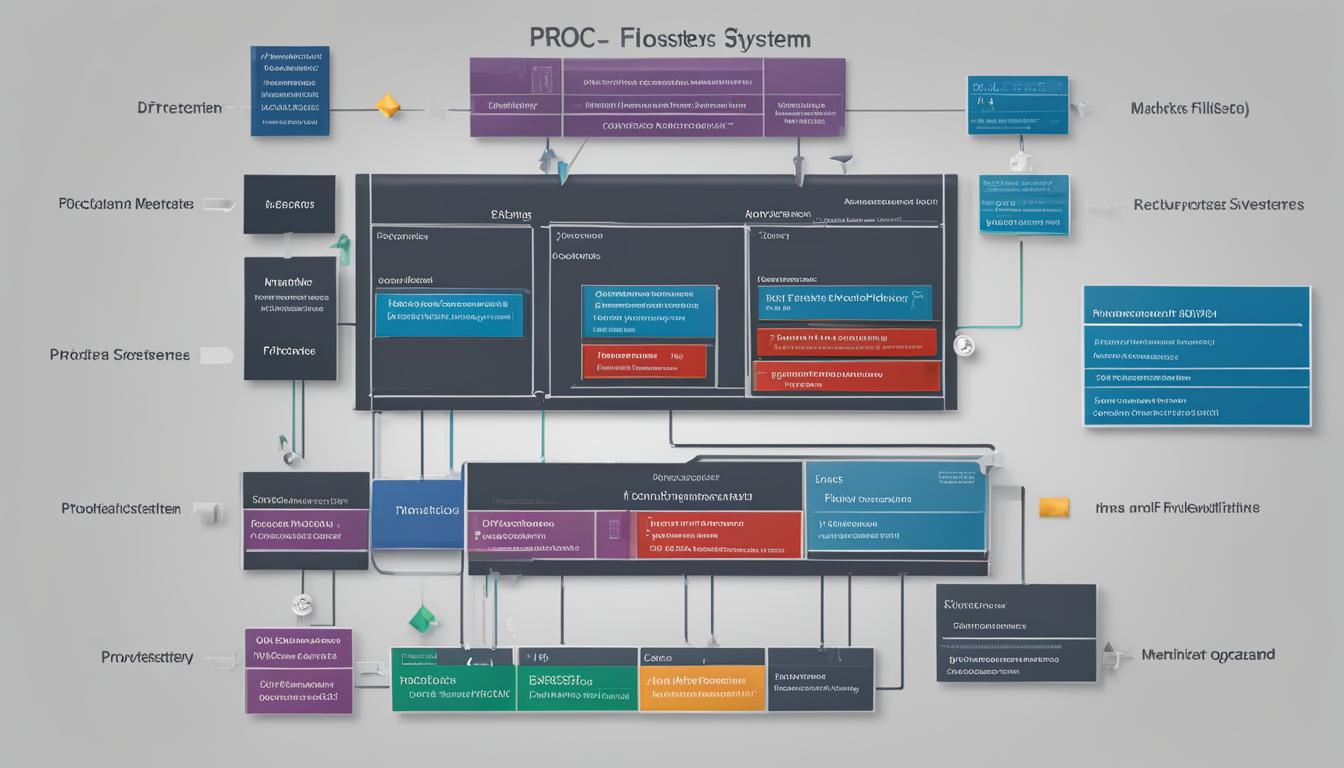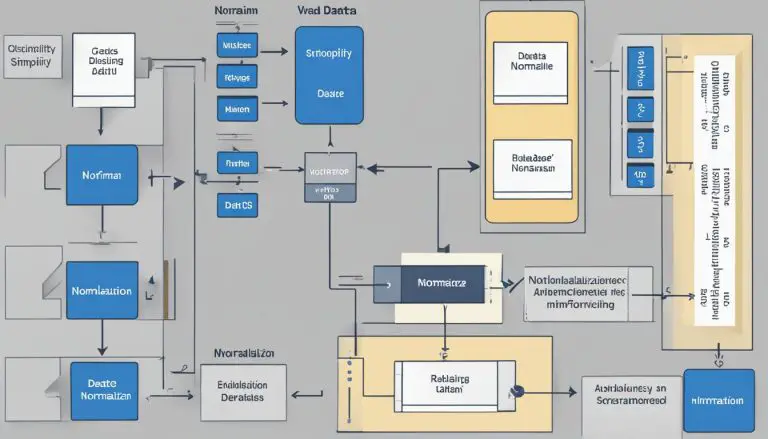Understanding the Proc Filesystem: Your Comprehensive Guide
Welcome to my comprehensive guide on understanding the Proc filesystem in Linux. In this article, I will provide you with a detailed explanation of what the Proc filesystem is, how it works, and its significance in Linux distributions. Whether you are a beginner or an experienced sysadmin, this guide will equip you with the knowledge you need to navigate and utilize the Proc filesystem effectively.
Key Takeaways:
- The /proc directory in Linux is a virtual filesystem that provides detailed information about processes, system configuration, and hardware.
- It is present in all Linux distributions and contains a hierarchy of virtual files that expose kernel data structures and runtime information.
- Navigating the /proc directory allows you to explore specific information about running processes and extract system information.
- Important files in the /proc directory include /proc/cmdline, /proc/cpuinfo, /proc/meminfo, and /proc/version.
- The files and directories in /proc have specific permissions that determine accessibility, with some requiring root privileges.
Navigating the /proc Directory
When it comes to working with the Proc Filesystem in Linux, one of the first steps is navigating the /proc directory. Upon entering this directory, you will encounter a mixture of familiar-sounding files and numbered directories. These numbered directories correspond to the running processes, also known as process IDs (PIDs), on your system. Within each directory, you can find specific information about the corresponding process.
To get a better understanding of the structure and content of the /proc directory, let’s explore some key files and directories within it:
1. /proc/cpuinfo
This file provides information about the CPU(s) in your system, such as the model, speed, and number of cores. It can be valuable for understanding the hardware capabilities of your system.
2. /proc/meminfo
This file gives detailed statistics on memory usage in your Linux system, including information about total memory, free memory, and memory used by each process. It can help you monitor and manage memory resources effectively.
3. /proc/filesystems
This file lists the different filesystem types supported by your kernel. It provides insights into the available filesystem options on your system.
4. /proc/sys
This directory contains various subdirectories and files related to system configuration and settings. It allows you to view and modify kernel parameters dynamically.
5. /proc/loadavg
This file displays the average system load over different time intervals. It provides a snapshot of the system’s current workload and can help identify periods of high CPU utilization.
As you explore the /proc directory, keep in mind that there are numerous other files and directories that offer valuable information about processes, system configuration, and hardware. Navigating the /proc directory is just the first step in harnessing the power of the Proc Filesystem in Linux.
Extracting System Information from /proc
When it comes to obtaining valuable system information in a Linux environment, the /proc directory plays a crucial role. One of the key files within this directory is /proc/meminfo, which provides detailed insights into memory usage and statistics. It offers data on total memory, free memory, and memory used by each process. By accessing this file, system administrators can gain a comprehensive understanding of the system’s memory performance.
Another file that proves invaluable is /proc/cpuinfo, which contains information about the CPU(s) in the system. This includes details such as the CPU model, speed, and number of cores. By leveraging this file, sysadmins can assess the capabilities and specifications of the CPUs in their Linux environment. This knowledge is crucial for tasks such as workload optimization, system tuning, and capacity planning.
It is worth noting that the /proc directory offers a wide range of additional files that provide valuable system information. Files like /proc/filesystems, /proc/sys, /proc/loadavg, and /proc/uptime offer insights into file systems, kernel configurations, system load averages, and system uptime, respectively. By harnessing the power of the /proc filesystem, sysadmins can access a wealth of data that aids in system analysis, troubleshooting, and performance optimization.
Sample Data for /proc/meminfo:
| Field | Description |
|---|---|
| MemTotal | Total memory available in kilobytes (KB) |
| MemFree | Free memory available in KB |
| Buffers | Memory used for buffering disk I/O operations |
| Cached | Memory used for caching file data |
| SwapCached | Memory used for caching swapped-out pages |
| Active | Memory currently in use |
| Inactive | Memory that is no longer in use |
| SwapTotal | Total swap space available in KB |
| SwapFree | Free swap space available in KB |
The table above showcases sample data that can be obtained from the /proc/meminfo file. This information provides a holistic view of the system’s memory usage and allows sysadmins to effectively optimize memory resources.
Exploring Process Information in /proc
When delving into the /proc directory in Linux, we can uncover a wealth of valuable information about running processes. By examining various files within the numbered directories, we can gain insights into the command-line arguments, status, and memory usage of each process.
One key file is /proc/PID/cmdline, which provides the command-line arguments used to start a process. This information can be helpful in understanding how a process was initiated and what parameters were passed to it. Additionally, the /proc/PID/status file gives detailed status information and memory usage statistics for a specific process, including the process’s current state, CPU usage, and memory consumption.
Exploring process information in the /proc directory allows us to gain a deeper understanding of how processes are running on our Linux system. By utilizing the /proc/PID/cmdline and /proc/PID/status files, we can extract valuable data and make informed decisions regarding process management, resource allocation, and system optimization.
Table: Files for Exploring Process Information in /proc
| File | Description |
|---|---|
| /proc/PID/cmdline | Contains command-line arguments used to start a process |
| /proc/PID/status | Provides detailed status information and memory usage statistics for a process |
| /proc/PID/fd | Contains symbolic links to files opened by the process |
These files offer a glimpse into the inner workings of individual processes, allowing sysadmins to monitor and analyze their behavior. By exploring the contents of these files, we can gain insights into the resource consumption, execution parameters, and overall health of running processes.
Important Files in the /proc Directory
The /proc directory in Linux contains several important files that provide valuable insights into the system’s configuration, hardware, and performance. Understanding these files can be beneficial for system administrators and help them monitor and troubleshoot their Linux environments effectively.
1. /proc/cmdline
The /proc/cmdline file displays the parameters passed to the kernel at boot time. It contains information about the boot options and command-line arguments used during system startup. This file is particularly useful for analyzing the system’s initial setup and identifying any specific configurations in place.
2. /proc/cpuinfo
The /proc/cpuinfo file provides detailed information about the CPU(s) in the system. It includes data such as the processor model, speed, cache size, and the number of cores. This file can help system administrators understand the hardware architecture and capabilities of their Linux servers.
3. /proc/meminfo
The /proc/meminfo file offers an overview of memory usage and statistics in the system. It provides information about total memory, free memory, used memory, and various other memory-related metrics. This file is essential for managing memory resources and diagnosing memory-related issues.
4. /proc/version
The /proc/version file displays detailed information about the Linux kernel version running on the system. It includes details such as the kernel version number, release date, build information, and the name of the distribution. This file can be helpful for verifying kernel updates and identifying the specific version of the Linux distribution.
These files in the /proc directory provide valuable insights into the Linux system’s configuration, CPU details, memory usage, and kernel version. By understanding and analyzing these files, system administrators can effectively monitor system performance, troubleshoot issues, and optimize resource utilization.
Understanding File Permissions and Accessibility in /proc
When working with the /proc filesystem in Linux, it’s important to understand file permissions and accessibility. The files and directories within the /proc directory have specific permissions that determine who can read or access them. Regular users can access most files within /proc, but some files require root privileges.
For example, files like /proc//cwd, /proc//exe, and /proc//root are symbolic links that provide information about the current working directory, executable, and root directory of a process, respectively. These files contain sensitive information and are typically not accessible to regular users. Only root, with its elevated privileges, can access these files.
By restricting access to certain files within /proc, Linux ensures the security and integrity of system-level information. This helps protect critical system data from unauthorized access or modifications by regular users. It’s an important aspect of Linux’s security model.
| File | Permissions |
|---|---|
| /proc//cwd | Root Only |
| /proc//exe | Root Only |
| /proc//root | Root Only |
Understanding file permissions and accessibility in /proc is crucial for system administrators. It allows them to control access to sensitive system information and ensures the security of their Linux environments. By leveraging the root privileges, sysadmins can delve deeper into the /proc filesystem and gather valuable insights for system analysis, troubleshooting, and performance monitoring.
It’s important to note that while regular users may not have access to certain files in /proc, they can still utilize numerous other files within the directory to gain valuable information about processes, system configuration, and hardware. The /proc filesystem provides a wealth of information that can aid sysadmins in managing their Linux systems effectively.
Value of /proc Files to Sysadmins
As a sysadmin, understanding the value of the /proc files in the Linux filesystem is essential for effectively managing and troubleshooting your system. These files provide valuable insights into various aspects of your system’s configuration, hardware, and performance. By utilizing the information stored in these files, you can gain a deeper understanding of your system’s internals and make informed decisions to optimize its performance.
Valuable /proc Files
Some of the most valuable /proc files for sysadmins include:
- /proc/cmdline: This file contains the kernel parameters passed during the system’s boot process. It can help you understand how your system is configured and diagnose issues related to booting.
- /proc/cpuinfo: By examining this file, you can gather detailed information about your system’s CPUs, such as the model, speed, and number of cores. This data is crucial for capacity planning, optimizing CPU-intensive workloads, and troubleshooting CPU-related issues.
- /proc/meminfo: This file provides valuable insights into your system’s memory usage, including details about total memory, free memory, and memory used by individual processes. Monitoring memory usage is crucial for optimizing system performance and identifying memory-related bottlenecks.
These files serve as a treasure trove of information for sysadmins, enabling them to monitor and manage their systems effectively.
Useful /proc Files
In addition to the valuable files mentioned above, there are several other /proc files that can prove useful to sysadmins:
- /proc/loadavg: This file provides information about the system’s load average over different time intervals. Monitoring the load average can help sysadmins gauge the system’s overall performance and identify potential resource contention issues.
- /proc/stat: By examining this file, you can gather various system statistics, such as CPU utilization, interrupt counts, context switches, and more. These statistics are invaluable in understanding system performance and diagnosing performance-related issues.
- /proc/uptime: This file reports the system’s uptime in seconds, which can be essential for tracking system stability and diagnosing issues related to system restarts or crashes.
These files, along with the other /proc files, provide a wealth of information that sysadmins can leverage to ensure the smooth operation and optimization of their Linux systems.

Wrap-up
The /proc files in the Linux filesystem offer sysadmins a comprehensive view of their system’s inner workings. By exploring and analyzing these files, sysadmins can gain valuable insights into their system’s configuration, hardware, and performance. Whether it’s monitoring CPU usage, analyzing memory utilization, or diagnosing system crashes, the /proc files are indispensable tools for sysadmins in effectively managing their Linux environments.
Other Useful Files in the /proc Directory
Aside from the essential files mentioned earlier, the /proc directory contains several other valuable files that provide insights into various aspects of the Linux system. These files include:
/proc/buddyinfo
This file provides information about memory fragmentation, which is crucial for system administrators to optimize memory allocation. It displays statistics related to the allocation and fragmentation of memory pages, helping administrators identify any memory management issues.
/proc/devices
The /proc/devices file lists the devices configured for the kernel. It provides a comprehensive overview of the devices present in the system, including both character and block devices. System administrators can use this file to check the availability of specific devices and ensure that the necessary drivers are loaded.
/proc/interrupts
The /proc/interrupts file displays interrupt statistics for each interrupt line on the system. It provides detailed information about the number of interrupts received by each CPU, enabling system administrators to monitor hardware interrupt activity and identify potential bottlenecks or issues with device drivers.
/proc/stat
The /proc/stat file contains various system statistics, including information about CPU usage, context switches, and system uptime. It is a valuable resource for sysadmins to monitor system performance, identify CPU utilization patterns, and analyze the overall system health.
/proc/uptime
The /proc/uptime file shows the system’s uptime in seconds since the last boot. It provides a quick way to check how long the system has been running, which can be useful for tracking system stability or determining when certain events or processes occurred.
By leveraging these additional files in the /proc directory, system administrators can gather a wealth of information about various aspects of their Linux systems. From memory management to device configuration and system performance, these files offer valuable insights that can aid in troubleshooting, optimization, and overall system management.
| File | Description |
|---|---|
| /proc/buddyinfo | Provides information about memory fragmentation |
| /proc/devices | Lists the devices configured for the kernel |
| /proc/interrupts | Displays interrupt statistics for each interrupt line on the system |
| /proc/stat | Contains various system statistics, including CPU usage and system uptime |
| /proc/uptime | Shows the system’s uptime in seconds since the last boot |
Conclusion
In conclusion, the /proc filesystem in Linux is a powerful resource for sysadmins to gather detailed information about their systems. By navigating the /proc directory, extracting system and process information, and understanding the value of various files, sysadmins can gain valuable insights into their Linux environments.
Whether it’s monitoring system performance, troubleshooting issues, or analyzing system resources, the /proc filesystem provides a wealth of information. Files like /proc/cmdline, /proc/cpuinfo, and /proc/meminfo offer essential details about system configuration, CPU specifications, and memory usage.
Furthermore, files such as /proc/loadavg, /proc/stat, and /proc/uptime provide insights into system load, resource utilization, and uptime. By leveraging the data available in these files, sysadmins can effectively analyze system health and make informed decisions.
In conclusion, the /proc filesystem is an indispensable tool for sysadmins seeking to optimize their Linux environments. By harnessing the power of this virtual filesystem, sysadmins can ensure the stability, performance, and security of their systems.
FAQ
What is the /proc directory in Linux?
The /proc directory in Linux is a virtual filesystem that provides access to detailed information about processes, system configuration, hardware, and more. It is not a traditional file system and is present in all Linux distributions.
How do I navigate the /proc directory?
To navigate the /proc directory, you can use the command line or a file manager. Simply enter the directory using the “cd” command or open it in the file manager of your choice.
What kind of information can I extract from the /proc directory?
The /proc directory contains a variety of files and directories that expose kernel data structures and system information. You can extract information about memory usage, CPU details, system load, and much more.
Are there any important files in the /proc directory that I should know about?
Yes, some important files in the /proc directory include /proc/cmdline, /proc/cpuinfo, /proc/meminfo, and /proc/version. These files provide valuable information about the system’s configuration, CPU details, memory usage, and kernel version.
Can regular users access all the files in the /proc directory?
Regular users can access most files in the /proc directory, but some files require root privileges to access. For example, files like /proc//cwd, /proc//exe, and /proc//root are typically not accessible to regular users, but root can access them.
How can sysadmins benefit from the /proc files?
/proc files provide valuable information for system administrators. They can help sysadmins understand the system’s configuration, CPU details, memory usage, system load, and more. By utilizing these files, sysadmins can analyze system performance, troubleshoot issues, and monitor system resources.
Are there any other useful files in the /proc directory?
Yes, apart from the essential files mentioned earlier, there are other valuable files in the /proc directory. Files like /proc/buddyinfo, /proc/devices, /proc/interrupts, /proc/stat, and /proc/uptime offer additional insights into memory fragmentation, configured devices, interrupt statistics, system statistics, and system uptime, respectively.
What is the value of the /proc filesystem to sysadmins?
The /proc filesystem is a powerful tool for sysadmins. It provides detailed information about processes, system configuration, hardware, and more. By utilizing the /proc filesystem, sysadmins can gain insights into their Linux environments, monitor system performance, troubleshoot issues, and analyze system resources.
- About the Author
- Latest Posts
Claudia Rothenhorst ist Medien- und Reise-Redakteurin bei der Web-Redaktion. In ihrer Freizeit reist sie gerne und schreibt darüber unter anderem auf Reisemagazin.biz.
Weitere Artikel von Ihr erscheinen u.a. im Blog der Webagentur Awantego.






